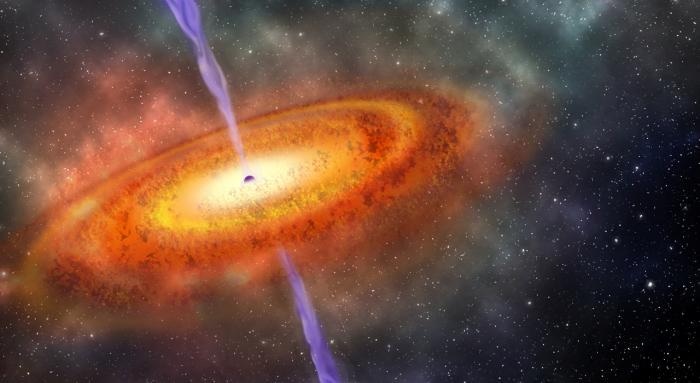Dec 7 2017
A team of astronomers led by Carnegie’s Eduardo Bañados used Carnegie’s Magellan telescopes to discover the most-distant supermassive black hole ever observed. It resides in a luminous quasar and its light reaches us from when the universe was only 5 percent of its current age—just 690 million years after the Big Bang. Their findings are published by Nature.
 Artist’s conceptions of the most-distant supermassive black hole ever discovered, which is part of a quasar from just 690 million years after the Big Bang. It is surrounded by neutral hydrogen, indicating that it is from the period called the epoch of reionization, when the universe's first light sources turned on. Illustrations by Robin Dienel, provided courtesy of the Carnegie Institution for Science.
Artist’s conceptions of the most-distant supermassive black hole ever discovered, which is part of a quasar from just 690 million years after the Big Bang. It is surrounded by neutral hydrogen, indicating that it is from the period called the epoch of reionization, when the universe's first light sources turned on. Illustrations by Robin Dienel, provided courtesy of the Carnegie Institution for Science.
Quasars are tremendously bright objects comprised of enormous black holes accreting matter at the centers of massive galaxies. This newly discovered black hole has a mass that is 800 million times the mass of our Sun.
“Gathering all this mass in fewer than 690 million years is an enormous challenge for theories of supermassive black hole growth,” Bañados explained.
To grow black holes that big so soon after the Big Bang, astronomers have speculated that the very early universe might have had conditions allowing the creation of very large black holes with masses reaching 100,000 times the mass of the Sun. This is very unlike the black holes that form in the present-day universe, which rarely exceed a few dozen solar masses.
Added Bram Venemans of the Max Planck Institute for Astronomy in Germany: “Quasars are among the brightest and most-distant known celestial objects and are crucial to understanding the early universe.”
The Bañados quasar is especially interesting, because it is from the time known as the epoch of reionization, when the universe emerged from its dark ages.
The Big Bang started the universe as a hot, murky soup of extremely energetic particles that was rapidly expanding. As it expanded, it cooled. About 400,000 years later (very quickly on a cosmic scale), these particles cooled and coalesced into neutral hydrogen gas. The universe stayed dark, without any luminous sources, until gravity condensed matter into the first stars and galaxies. The energy released by these ancient galaxies caused the neutral hydrogen strewn throughout the universe to get excited and ionize, or lose an electron, a state that the gas has remained in since that time. Once the universe became reionzed, photons could travel freely throughout space, thus the universe became transparent to light.
Analysis of the newly found quasar shows that a large fraction of the hydrogen in its immediate surroundings is neutral, indicating that the astronomers have identified a source in the epoch of reionization, before enough of the first stars and galaxies have turned on to fully re-ionize the universe.
“It was the universe’s last major transition and one of the current frontiers of astrophysics,” Bañados said.
The quasar’s distance is determined by what’s called its redshift, which is a measurement of how much the wavelength of its light is stretched by the expansion of the universe before reaching Earth. The higher the redshift, the greater the distance, and the further back astronomers are looking in time when they observe the object. This newly discovered quasar has a redshift of 7.54, based on the detection of ionized carbon emissions from the galaxy that hosts the massive black hole. It took more than 13 billion years for the light from the quasar to reach us. The characterization of the quasar host galaxy was carried out with the IRAM/NOEMA and JVLA interferometers and the findings are reported in a companion article published in The Astrophysical Journal Letters led by Bram Venemans.
“This great distance makes such objects extremely faint when viewed from Earth. Early quasars are also very rare on the sky. Only one quasar was known to exist at a redshift greater than seven before now, despite extensive searching,” said Xiaohui Fan of the University of Arizona’s Steward Observatory.
Between 20 and 100 quasars as bright and as distant as the quasar discovered by Bañados and his team are predicted to exist over the whole sky, so this is a major discovery that will provide fundamental information of the young universe, when it was only 5 percent its current age.
"This is a very exciting discovery, found by scouring the new generation of wide-area, sensitive surveys astronomers are conducting using NASA's Wide-field Infrared Survey Explorer in orbit and ground-based telescopes in Chile and Hawaii," said Daniel Stern of NASA’s Jet Propulsion Laboratory in Pasadena. “With several next-generation, even-more-sensitive facilities currently being built, we can expect many exciting discoveries in the very early universe in the coming years.”
The team used two Magellan telescope instruments to observe the supermassive black hole: FIRE, which made the discovery, and Fourstar, which was used for additional images.
"This important discovery—together with the detection of distant galaxies—is elucidating the conditions of the universe during the reionization epoch. While we wait for the construction of the new generation of giant telescopes, such as the GMT, telescopes such as the Magellans at Las Campanas Observatory in Chile will continue to play a crucial role in the study of the early universe," added Las Campanas Director Leopoldo Infante.